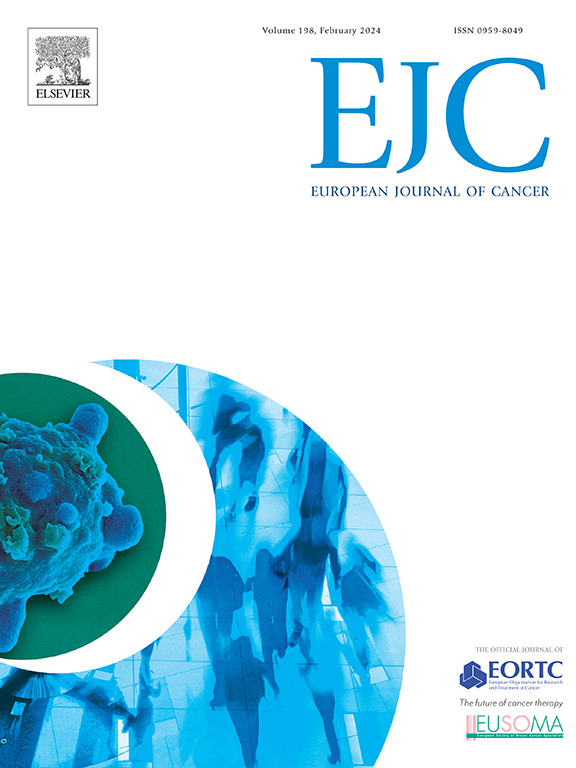Phase 1/2 study of liposomal irinotecan plus S-1 for metastatic pancreatic cancer refractory to gemcitabine-based treatment
IF 7.6
1区 医学
Q1 ONCOLOGY
引用次数: 0
Abstract
Background
Liposomal irinotecan (nal-IRI) plus fluorouracil/folinic acid (5-FU/LV) improves survival in gemcitabine-refractory metastatic pancreatic cancer (PC) but requires a central venous port. S-1, an oral fluoropyrimidine with proven efficacy in PC, may replace 5-FU/LV in nal-IRI plus 5-FU/LV, potentially enhancing both convenience and antitumor effect.
Methods
This single-arm, open-label, phase 1/2 study included patients with histologically or cytologically confirmed adenocarcinoma, aged 20–80 years, an Eastern Cooperative Oncology Group performance status of 0–1, with metastatic disease, and refractory to gemcitabine-based treatment. The primary endpoint in phase 1 part was the frequency of dose-limiting toxicity (DLT) to nal-IRI plus S-1. The primary endpoint in phase 2 part was overall survival. This trial was registered in the Japan Registry of Clinical Trials database (jRCTs031210040).
Results
In phase 1 part, one patient with DLT was observed at nal-IRI 70 mg/m2 (day 1) with S-1 80 mg/m2/day (day 1–7) in a 2-week cycle, establishing this as the recommended phase 2 dose (RP2D). Forty-nine patients from phase 1 (n = 6) and phase 2 part (n = 43) were treated with the RP2D, and their results were pooled. Median overall survival was 10.3 months (95 % confidence interval, 8.1–12.0 months). A confirmed partial response was achieved in 10 patients (20.4 %). The most frequent treatment-emergent adverse events were hypoalbuminemia (98.0 %), anemia (98.0 %), and anorexia (81.6 %). There were no treatment-related deaths.
Conclusions
This study demonstrated that nal-IRI plus S-1 exhibited promising efficacy and an acceptable safety profile in patients with metastatic PC refractory to gemcitabine-based treatment.
伊立替康加S-1脂质体对吉西他滨治疗难治的转移性胰腺癌的1/2期研究
伊立替康脂质体(nal-IRI)加氟尿嘧啶/亚叶酸(5-FU/LV)可提高吉西他滨难治性转移性胰腺癌(PC)的生存率,但需要中心静脉通道。S-1是一种口服氟嘧啶,经证实对PC有效,可替代nal-IRI + 5-FU/LV的5-FU/LV,可能增强便利性和抗肿瘤效果。方法:这项单臂、开放标签、1/2期研究纳入组织学或细胞学证实的腺癌患者,年龄20-80岁,东部肿瘤合作组(Eastern Cooperative Oncology Group)表现状态0-1,有转移性疾病,对吉西他滨治疗难治。第一阶段的主要终点是剂量限制性毒性(DLT)对nal-IRI + S-1的频率。第二阶段的主要终点是总生存期。该试验已在日本临床试验注册数据库(jRCTs031210040)中注册。结果在1期研究中,1例DLT患者接受nal-IRI剂量为70 mg/m2(第1天),S-1剂量为80 mg/m2/天(第1 - 7天),疗程为2周,确定该剂量为推荐的2期剂量(RP2D)。来自1期(n = 6)和2期(n = 43)的49例患者接受了RP2D治疗,并汇总了他们的结果。中位总生存期为10.3个月(95 %置信区间,8.1-12.0个月)。10例患者获得部分缓解(20.4 %)。最常见的治疗不良事件是低白蛋白血症(98.0% %)、贫血(98.0% %)和厌食症(81.6% %)。没有与治疗相关的死亡。结论:本研究表明,nal-IRI加S-1在吉西他滨治疗难治性转移性PC患者中表现出良好的疗效和可接受的安全性。
本文章由计算机程序翻译,如有差异,请以英文原文为准。
求助全文
约1分钟内获得全文
求助全文
来源期刊

European Journal of Cancer
医学-肿瘤学
CiteScore
11.50
自引率
4.80%
发文量
953
审稿时长
23 days
期刊介绍:
The European Journal of Cancer (EJC) serves as a comprehensive platform integrating preclinical, digital, translational, and clinical research across the spectrum of cancer. From epidemiology, carcinogenesis, and biology to groundbreaking innovations in cancer treatment and patient care, the journal covers a wide array of topics. We publish original research, reviews, previews, editorial comments, and correspondence, fostering dialogue and advancement in the fight against cancer. Join us in our mission to drive progress and improve outcomes in cancer research and patient care.
 求助内容:
求助内容: 应助结果提醒方式:
应助结果提醒方式:


